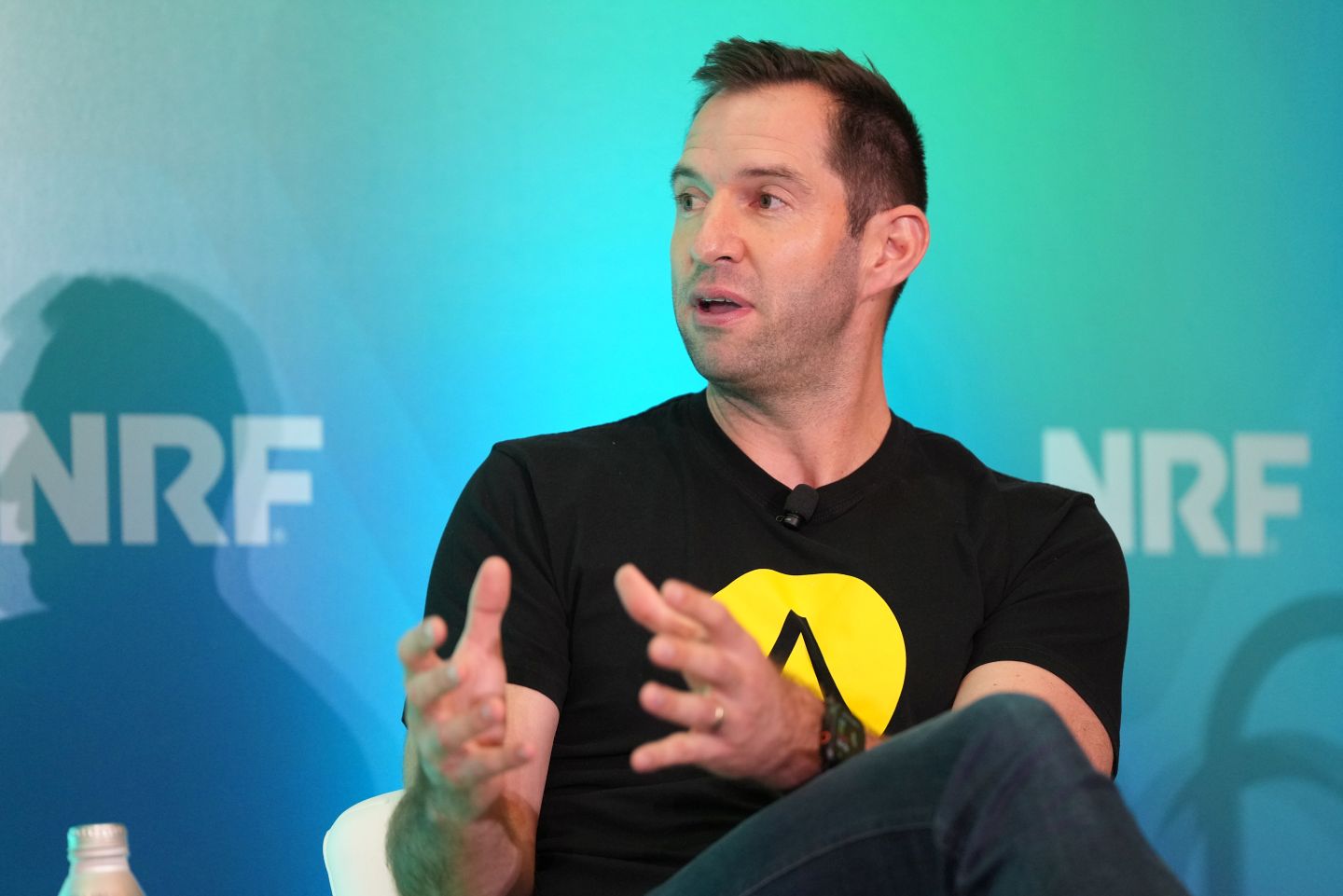
From left: Terry Sullivan, senior vice president of strategic partnerships at Auror, speaks with Ulta Beauty Senior Vice President of Loss Prevention Dan Petrousek, Meijer Stores Inc. Vice President of Asset Protection, Safety and Corporate Services Paul Jaeckle and Auror CEO and co-founder Phil Thomson at NRF PROTECT 2025.
When Phil Thomson learned that some retailers wouldn’t allow female employees to work after 4 p.m. as it was deemed “too unsafe,” it rocked him. He began to wonder what sort of society he was living in, that this strategy for fighting violent crime was considered “OK as an outcome.”

Auror CEO and co-founder Phil Thomson speaks at NRF PROTECT 2025.
It was time for a rallying cry. Thomson is CEO and co-founder of Auror, a crime intelligence software company aimed at helping retailers securely record crime, reduce loss and make stores safer. Reducing retail violence is square in his company’s sights. Auror’s new shared mission is to work together with retailers, law enforcement and the community to reduce violent retail crime by 50% in the next five years.
Thomson laid out Auror’s “50 in 5” call to action during a session at NRF PROTECT 2025 that included Paul Jaeckle, vice president, asset protection, safety and corporate services, Meijer Stores Inc., and Ulta Beauty Senior Vice President, Loss Prevention Dan Petrousek. Terry Sullivan, senior vice president, strategic partnerships, Auror, moderated.
Auror, founded in 2012, spent its first decade focused on providing visibility around the true scale and severity of retail crime, improving the experience of reporting, investigation and collaboration. More recently, however, there’s been an uptick not only in retail violence — with Auror’s own U.S. retailer data showing one in eight retail events now involve threatening behavior — but also the introduction of more hardened criminals, Thomson said: Repeat offenders are up to four times more likely to be violent in retail settings.
Auror works with enterprise retailers in Australia, New Zealand, North America and the United Kingdom, and is hopeful to bring the weight of the global community to the issue.
The retailers present admitted the “50 in 5” effort is bold. It’s also timely. The COVID era brought deep changes in the way people interact, with violence becoming more personal, aggressive and overt.
Further, the panelists shared, organized crime syndicates are increasingly using retail theft as a component of their broader business. Thomson noted that 10% of offenders now cause more than 60% of all retail crimes — and it’s the same in every market where the company operates. Violence isn’t the goal; it’s simply a tactic used to get the desired goods.
Detecting and stopping the repeat offenders, however, could have significant impact, in addition to “connecting the dots” to disrupt crime networks, among other strategies.
Panelists shared their concerns about their team members, who might range from teens and young adults in their first jobs to seniors working part-time. They also worried about vulnerable shoppers, perhaps with young children in tow, as well as their own family members.
“Shrink gives me a headache,” Jaeckle said. “The violence in the stores is what keeps me up at night.”
In many ways, those in the retail space operate as competitors, Petrousek said. “But it’s imperative that we work together, collaboratively, around this effort.”
Partnership with other retailers is critically important, as well as partnership with law enforcement, technology solution providers, legislators and prosecutors. (NRF noted in its report, “The Impact of Retail Theft & Violence 2024,” that retail theft remains underreported to law enforcement. From the same report: “Between 2022 and 2023, retailers that track these incidents specifically saw a 42% increase in shoplifting incidents that involved threats or acts of violence and a 39% increase in incidents involving the threat, display or use of a weapon.”)
Browse NRF's various retail safety and security resources including topics, articles, reports and more.
The panelists shared experiences related to their teams, internal processes, training, data, partnerships and tactics — including educating law enforcement, government authorities, leadership and community members on the scope of the problem. It’s far more than a mere “nuisance.”
They also encouraged audience members to communicate transparently and openly with store teams about the challenges and what’s being done to deal with them; to consider deploying uniformed police officers if it helps store teams feel more supported; to focus on those repeat offenders; to utilize technology; to learn more about the effort; and to be persistent.
“Every day matters, and I think it’s absolutely achievable,” Jaeckle said. “I think we’re responsible to be able to do it one way or another, but it’s not going to be an easy fight, right? The world continues to change on you. So continuing to be persistent is going to be key.”